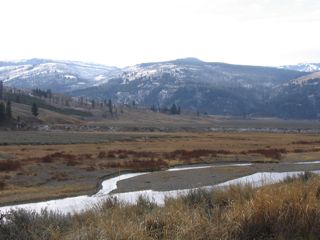 Chorus Frog Crawling on Author's HomeWhen I relocated from Yosemite to Yellowstone, I had to adjust to subzero temperatures, a lack of Thai food, and being in the middle of the food chain. Yet the most difficult alteration involved the shortage of my favorite animals: frogs.
Chorus Frog Crawling on Author's HomeWhen I relocated from Yosemite to Yellowstone, I had to adjust to subzero temperatures, a lack of Thai food, and being in the middle of the food chain. Yet the most difficult alteration involved the shortage of my favorite animals: frogs.
In my home outside of Yosemite, the delicate pacific chorus frogs decorated my windows as they prowled for moths, and on my hikes in the Sierra I often encountered the mountain yellow-legged frog lounging around sunny stream banks. As I reported in a prior entry, Yosemite’s amphibians have declined alarmingly in recent years—some populations of the mountain yellow-legged have been reduced by over 90 percent in the Sierra Nevada.
Amphibians in Yellowstone are scarce—and getting scarcer. Yellowstone’s harsh climate supports only four species of amphibians: boreal toad, boreal chorus frog, Columbia spotted frog, and the tiger salamander. Unfortunately, these animals have also recently experienced steep declines according to a study just published in the Proceedings of the National Academy of Sciences (PSNA) entitled “Climatic Change and Wetland Desiccation Cause Amphibian Decline in Yellowstone National Park.”
 Columbia Spotted Frog (NPS Library)Authors Sarah McMenamin, Elizabeth Hadly, and Christopher Wright surveyed kettle ponds (ponds originally formed when glaciers retreated and fed by snowmelt and groundwater) between 2006 and 2008 in Yellowstone's Lamar Valley. They discovered that dry ponds have increased 4-fold in the past sixteen years, and as a result eliminated a large segment of ideal amphibian habitat in the park. Even more troubling, the study found that three of the four amphibian species in Yellowstone had experienced sharp declines in their populations.
Columbia Spotted Frog (NPS Library)Authors Sarah McMenamin, Elizabeth Hadly, and Christopher Wright surveyed kettle ponds (ponds originally formed when glaciers retreated and fed by snowmelt and groundwater) between 2006 and 2008 in Yellowstone's Lamar Valley. They discovered that dry ponds have increased 4-fold in the past sixteen years, and as a result eliminated a large segment of ideal amphibian habitat in the park. Even more troubling, the study found that three of the four amphibian species in Yellowstone had experienced sharp declines in their populations.
 Lamar Valley in Yellowstone: Location of StudyMs. McMenamin told the BBC News, "There is a pretty substantial signal of climate change in this region." The report introduction also raises an alarm: “Our results indicate that climatic warming already has disrupted one of the best-protected ecosystems on our planet and that current assessment of species vulnerability do not adequately consider such impacts.”
Lamar Valley in Yellowstone: Location of StudyMs. McMenamin told the BBC News, "There is a pretty substantial signal of climate change in this region." The report introduction also raises an alarm: “Our results indicate that climatic warming already has disrupted one of the best-protected ecosystems on our planet and that current assessment of species vulnerability do not adequately consider such impacts.”
Aside from the devastation this news causes frog-o-philes like me, why is the disappearing amphibians cause for concern? Amphibians have been characterized as an indicator species—because of their sensitivity to environmental degradation, they act as a bellwether for change. As David Wake, author of another study on amphibian decline recently stated, "There's no question that we are in a mass extinction spasm right now. Amphibians have been around for about 250 million years. They made it through when the dinosaurs didn't. The fact that they're cutting out now should be a lesson for us.”
